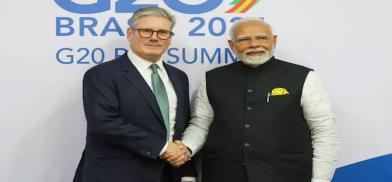India–UK Free Trade Agreement: A Blueprint for Forward-Thinking Global Commerce
The broader strategic ramifications of the India–UK FTA are profound. It strengthens bilateral cooperation in areas such as defence, technology, renewable energy, and education, reinforcing both countries’ strategic footprints in the Indo-Pacific region.

The finalization of the India–UK Free Trade Agreement (FTA) marks a historic moment in international trade diplomacy. This deal, described as the most comprehensive and economically significant bilateral pact the United Kingdom has signed since Brexit, is equally important for India, which has strategically avoided regional mega agreements like the Regional Comprehensive Economic Partnership (RCEP). By entering into this landmark agreement with the UK, India is not only realigning its trade priorities but also asserting its role as a critical player in shaping the future of global trade. The FTA represents India’s largest and most ambitious trade accord in over a decade, particularly notable after its deliberate withdrawal from the RCEP in 2019 over concerns regarding China's dominance in that bloc.
The India–UK FTA substantially liberalizes trade in both goods and services. Nearly 99% of Indian exports to the UK will now enter duty-free, a major boost for labour-intensive sectors such as textiles, leather, apparel, gems and jewellery, marine products, and auto components. In return, India has agreed to eliminate or phase out tariffs on about 90% of UK goods, with 85% becoming fully tariff-free within ten years. This includes high-value British exports such as whisky, automobiles, medical devices, machinery, and premium foods. For instance, Scotch whisky tariffs in India will be cut from 150% to 75% immediately, and eventually down to 40% over the next decade, opening vast consumer markets for British distillers. UK cars and electrical equipment, which currently face import duties exceeding 100%, will also benefit from reduced tariffs under a carefully structured quota system.
Unprecedented Market Access
The agreement is not limited to trade in physical goods. It provides unprecedented market access for Indian service providers in IT, healthcare, finance, legal consultancy, education, and the creative industries. Indian professionals such as yoga instructors, chefs, artists, and musicians will now be eligible for short-term visas, freelance opportunities, and intra-company transfers, further enhancing India’s stronghold in global knowledge and creative economies. A three-year exemption from social security contributions for Indian professionals working in the UK adds another layer of economic relief and attractiveness for both talent and employers.
In terms of regulatory alignment, the FTA lays the foundation for smoother customs procedures, mutual recognition of standards, and simplification of rules of origin. These changes will particularly benefit small and medium-sized enterprises (SMEs) on both sides, which often struggle to comply with complex trade documentation and technical regulations. In addition, provisions on digital trade, e-commerce, and data protection reflect the modern character of this agreement, showing that the India–UK FTA is as much about the future as it is about present-day commerce.
Win-win Scenario
The projected economic impact of this deal is considerable. Bilateral trade, which stood at around $55–60 billion in 2024, is expected to rise to over $100–120 billion by 2030, effectively doubling within the next five years. The UK government anticipates that the FTA will add £4.8 billion to its GDP annually, while boosting workers’ wages by over £2 billion. India, in turn, is estimated to gain between 0.07% to 0.16% of GDP, driven primarily by increased exports and job creation in key sectors. These macroeconomic indicators point to a win-win scenario for both countries, reinforcing their economic complementarity and shared growth trajectories.
Significance of FTA
What makes this deal globally significant is its geopolitical and trade policy context. For India, this is the most comprehensive FTA it has signed since walking away from the RCEP, and it signals a clear shift in its trade strategy. Rather than engaging in multilateral trade blocs dominated by a single power, India is increasingly pursuing high-quality bilateral deals that protect domestic interests while enabling global integration. For the UK, this FTA is a linchpin of its post-Brexit trade diversification strategy. By securing deeper economic ties with India, one of the world’s fastest-growing large economies, the UK reduces its dependence on the European Union and China, while reinforcing its role in the Indo-Pacific.
At the global level, the India–UK FTA is expected to influence supply chains, regional trade alignments, and future trade negotiations. Indian manufacturers, especially in sectors like automotive components, pharmaceuticals, engineering goods, and textiles, can now integrate more effectively into global value chains, thanks to easier access to high-tech UK capital goods and reduced tariff burdens. Indian exports are expected to capture a greater share of the UK market, particularly in categories where China, Vietnam, and Bangladesh have traditionally held sway. Simultaneously, UK exporters stand to regain lost ground in India’s premium market segments, ranging from beverages and luxury vehicles to aerospace and health technologies.
Moreover, the agreement sets a new standard for trade in services, mobility, and regulatory cooperation—areas that are increasingly vital in a global economy powered by knowledge and digital innovation. It also serves as a model for India’s ongoing trade talks with the European Union and the United States, providing a tested framework for negotiating services liberalization, professional mobility, digital trade norms, and intellectual property protection. This bilateral success could very well act as a stepping stone for India's future membership in broader trade partnerships such as the Comprehensive and Progressive Agreement for Trans-Pacific Partnership (CPTPP).
Challenges and Hurdles
Nevertheless, the deal is not without its challenges and risks. One pressing concern is the potential impact of the UK’s proposed Carbon Border Adjustment Mechanism (CBAM), which aims to impose carbon tariffs on energy-intensive imports such as steel, cement, and fertilizers. Without a clear exemption or transition framework in place, Indian exporters in these sectors could face punitive duties, undercutting some of the benefits they stand to gain from tariff elimination. Analysts estimate that up to $775 million of Indian exports could be affected if CBAM is enforced without adjustment.
Furthermore, while large corporations are well-positioned to take advantage of the FTA, smaller Indian enterprises may struggle with the compliance burden. Rules of origin documentation, quality standards, and digital customs platforms require a level of administrative capacity that many SMEs currently lack. Without targeted government support and capacity-building efforts, these smaller firms risk being sidelined, which could create inequities in how the FTA’s benefits are distributed across India’s diverse business ecosystem.
Domestic political challenges could also pose headwinds. In the UK, opposition parties have raised concerns about visa concessions and social security exemptions offered to Indian professionals, claiming they create a two-tiered system that favors foreign workers over locals. In India, protectionist factions remain wary of greater import competition in sensitive sectors such as agriculture, dairy, and some manufacturing segments. These issues, while not deal-breakers, could influence the pace and scope of implementation, as both countries gear up for elections in the coming years.
Despite these hurdles, the broader strategic ramifications of the India–UK FTA are profound. It strengthens bilateral cooperation in areas such as defence, technology, renewable energy, and education, reinforcing both countries’ strategic footprints in the Indo-Pacific region. It also builds momentum for future economic integration initiatives and deepens trust between two democratic nations with shared colonial histories but increasingly convergent futures. By lowering trade barriers, enhancing service sector mobility, and encouraging regulatory harmonization, the FTA embodies a new generation of global trade agreements that are more dynamic, inclusive, and forward-looking.
The India–UK Free Trade Agreement is not just a milestone in bilateral relations—it is a harbinger of shifting global trade patterns. For India, it signals a pivot toward self-assured, interest-based globalization, where the country chooses partnerships that align with its development goals and geopolitical interests. For the UK, it is a pragmatic response to the complexities of a post-Brexit world, offering both economic growth and strategic diversification. And for the world at large, this FTA may well set the tone for how emerging economies and advanced markets can cooperate on equal terms, beyond the shadow of older trade blocs and toward a more multipolar economic future. As countries recalibrate their positions in an evolving trade order, the India–UK FTA stands as a blueprint for resilient, equitable, and forward-thinking international commerce
(The writer, a political science graduate from Guru Nanak Dev University, India, is a contemporary affairs analyst. Views are personal. She can be contacted at anubham95@gmail.com).









Post a Comment